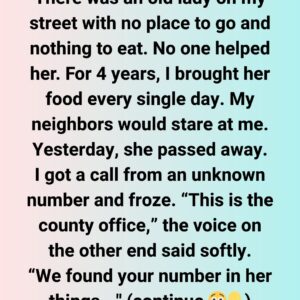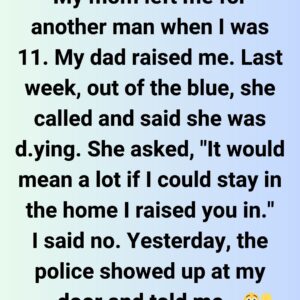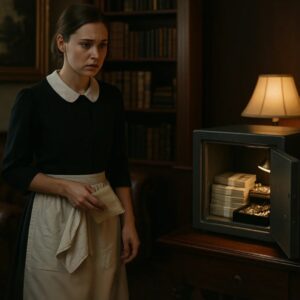Grief is a strange companion. It doesn’t always announce itself with wailing or collapse into someone’s arms. Sometimes, it shows up quietly, sitting beside you without saying a word.
It can be hidden in daily routines, in the way a hand lingers too long on a photograph, or in the ritual of folding a blanket that no one has used in years. People think grief is loud, dramatic, something the world can instantly recognize—but often, it’s private, unspoken, and disguised as silence. When my son died at sixteen, the sound of my grief could have shaken the walls.
I cried until my throat ached, screamed into pillows until I could hardly breathe, and sat up at night replaying every single moment I wished I had done differently. His absence hollowed me out, and I lived inside that emptiness for months, maybe years. But Sam, my husband, seemed untouched.
He didn’t cry at the funeral. He didn’t collapse into bed when the weight became unbearable. He didn’t even talk about our boy after those first few weeks.
At first, I thought maybe he was just being strong for me. I clung to that idea, because the alternative—that he wasn’t grieving at all—felt too cruel. But time passed, and Sam never once showed the grief I expected to see.
I began to resent him for it. I wanted to see him broken, like I was. I wanted him to hurt openly so I wouldn’t feel so alone in the devastation.
But Sam never shed a tear. The months turned into years, and our family slowly drifted apart, the distance widening like cracks in old glass. Eventually, those cracks shattered completely, and we divorced.
By then, I was convinced he had never really loved our son the way I had. I told myself that his silence was indifference, that his lack of tears was proof of some coldness in him I had never truly seen before. It was easier, in a painful way, to believe that than to imagine something else I couldn’t understand.
Life carried on in its relentless way. Sam remarried. I tried to rebuild my world in small, fragile pieces.
We hardly spoke, and when we did, it was polite, distant, like two strangers who had once known each other well but had long since left that life behind. And then, twelve years later, Sam died too. Some days after his death, his wife came to see me.
I wasn’t sure what she wanted—maybe closure, maybe kindness, maybe to bridge some connection between us now that Sam was gone. But when she sat across from me, she didn’t look like someone delivering condolences. She looked like someone carrying a secret too heavy to keep any longer.
She held a small wooden box in her hands. It was plain, worn down by years of touch, the corners smoothed as though they had been pressed and handled again and again. She looked at me carefully, her voice quiet but steady.
“It’s time you know the truth,” she said. I stared at her, confused, not sure what truth she meant. She placed the box into my hands.
It was heavier than it looked, as though it carried more than just its contents. Inside, I found dozens of envelopes. Each one was carefully sealed, and across the front, in Sam’s handwriting, was our son’s name.
My breath caught in my throat. “Every year, on his birthday,” she explained softly, “Sam went to the same quiet hill and wrote to him. He never let anyone see, but this was how he grieved.
This was how he stayed connected. He carried this pain silently all these years.”
I sat there frozen, my hands trembling around that little box, unable to speak. For years, I had believed Sam felt nothing.
I had convinced myself his heart was stone, untouched by our son’s death. But here, in my lap, was undeniable proof that he had carried his grief all along—just differently, in a way I never recognized. I opened one of the letters.
The paper was soft from age, the ink slightly faded, but the words were alive. He wrote about memories of our boy, about his laughter echoing down the hall, about the way his smile lit up even the darkest days. Some letters were full of stories, little details Sam wanted to preserve before time could take them away.
Others were apologies—for things he wished he could change, for arguments he wished had never happened, for not being able to protect him from the unthinkable. And others were simple, almost childlike in their tenderness: I miss you. I love you.
I’ll always be your dad. I read letter after letter, my tears dripping onto the pages, blurring his words. I could see Sam so clearly in every line, hear his voice in the rhythm of each sentence.
He had spoken to our son year after year, never missing a birthday, never allowing the silence of the world to erase the bond he still felt. This was his grief, hidden from the world but etched forever in ink. I realized then how blind I had been.
For years, I judged him for not crying like I cried, for not falling apart like I did. I believed his silence meant absence, when really, it meant devotion. His grief was not loud, but it was constant.
It was a private ritual he carried alone because he didn’t know how to share it, maybe because he was afraid it would fall apart if he let anyone else see it. The weight of that realization crushed me and lifted me all at once. I wept not only for my son but for Sam—for the man who had carried this sorrow silently, year after year, without ever asking for comfort.
I wept for the years I had spent resenting him, for the walls that had grown between us because I thought his silence was emptiness. And I wept for the letters themselves, proof that love and grief are often intertwined in ways we cannot see. As I read on, I noticed something else.
The letters were not just about sadness. They carried hope too. He wrote as though our boy could still hear him, as though somewhere, somehow, his words were reaching him.
He wrote about what he wished he could have taught him, what he hoped he was still watching, the lessons he wished he could have passed down. He wrote like a father still parenting, still guiding, still holding on. And in that, I saw not just grief but love that refused to fade.
I thought back to the years after our loss, to the arguments, the distance, the bitterness that had grown between us. If only I had known. If only I had seen.
Maybe things would have been different. Maybe we wouldn’t have let grief divide us when it could have bound us together. But grief doesn’t come with instructions, and love doesn’t always wear the face we expect.
That night, I sat with the box for hours, reading until my eyes ached. Every letter painted a fuller picture of the man I had once loved. He wasn’t cold.
He wasn’t distant. He was simply broken in a way I had never understood. And in that silence, he had been speaking to our son all along.
It’s easy to believe that grief must look like our own to be real. We search for tears, for trembling voices, for someone collapsing under the weight of their sorrow. But grief is not uniform.
Some people cry until they are empty. Others write until the ink runs dry. Some visit graves every week, while others avoid them entirely because the sight is too much to bear.
None of these ways are wrong. None of them mean the love is smaller or the pain is lighter. They are just different.
Sam’s way was quiet, but it was steady. He never let go. He carried our son with him in every word he wrote, every year, without fail.
That was his mourning, his ritual, his connection. And I finally understood. When people say time heals, they rarely mention how uneven that healing is.
For some, it feels like scars slowly forming, the wound less raw but always there. For others, it feels like carrying a weight that never lessens, only becoming more familiar in your hands. And sometimes, for people like Sam, it feels like letters written on a hill, whispered to the wind, kept close in a box no one else ever sees.
Holding those letters, I learned the lesson I wish I had known years earlier: grief wears many faces. Just because someone doesn’t show it the way you expect doesn’t mean they aren’t living it, breathing it, carrying it every single day. Love doesn’t always shout.
Sometimes, it whispers. Sometimes, it hides in silence, in the curl of handwriting on an envelope, in a ritual performed in solitude. I think of Sam differently now.
I no longer see him as the man who refused to cry. I see him as the man who chose silence, who poured his grief into ink because he didn’t know how else to survive it. And in that way, he honored our son, year after year, with words that were never spoken aloud but were filled with love all the same.
We spend so much time expecting grief to look like our own. But true understanding comes when we let go of those expectations and simply listen—to the words spoken and the ones left unsaid. Compassion, not judgment, is what brings healing.





